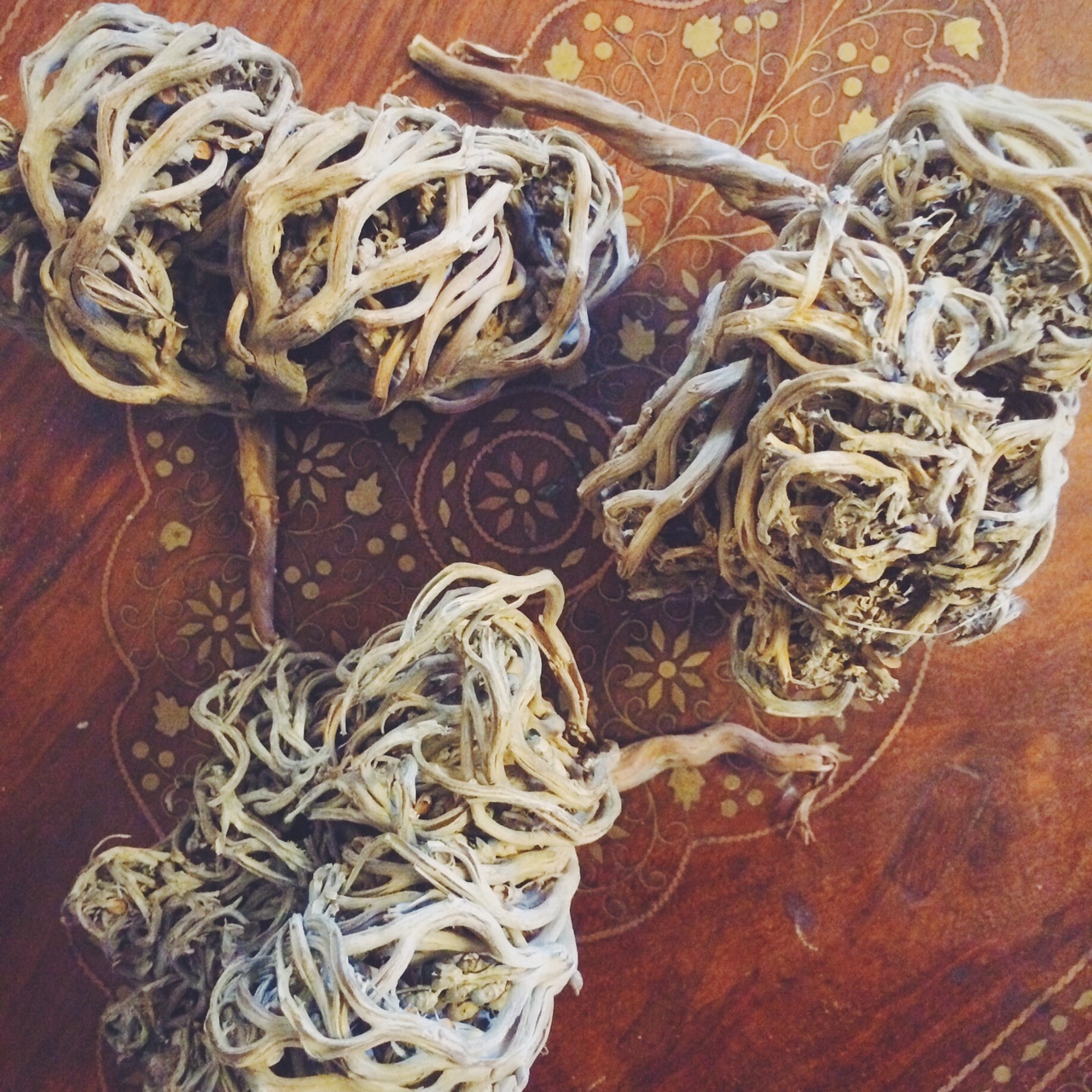The Flower of Maryam
I sometimes have these plants in my Etsy shop. If I don't have any currently in stock, check back periodically. Also, if you're looking for Flower of Maryam to help with your birth or with your fertility and would be interested in exploring other herbs, please check out my herbal consultation page. I love working with women locally and over Skype to prepare for pregnancy, to conceive their babies, and to prepare for birth!
Labor begins, and the midwife places a small dry twiggy rosette in a bowl of warm water near the mother. Labor continues, the mother gently perspires, her cervix is softening and opening, and as it does, the ball of twigs begins to soften and expand into a woody flower. She takes a sip of the medicinal water, and, breathing deeply, she watches as the ball fully blossoms. Soon enough, she’s ready to push…
The Flower of Maryam (Anastatica hierochuntica) is a small shrub collected across North Africa, Saudi Arabia, Iran, and Pakistan, and among its most popular medicinal uses is its application for childbirth. Whether its medicinal properties encourage dilation, or if it’s a powerful visualization tool for mothers, traditional midwives have used the Flower of Maryam with their laboring mothers for hundreds of years. A quick glance at its names (below) suggests its religious significance: it is referred to as the “leaf of Maryam” (mother of Jesus), the “hand of Fatima” (daughter of the Prophet ﷺ), as well as simply “daughter of the Prophet ﷺ,” and “resurrection plant.” It is referenced in the Bible in II Kings 19:34-36 and in Psalms 83:13, “make them like tumbleweed,” here referring to the dried twiggy balls of Anastatica that disperse in the wind, scattering its seeds.
Anastatica is notable for its ability to survive in arid conditions—it simply dries up into a ball and awaits the next rain, at which point it reveals small slender leaves and tiny white flowers. It is hygroscopic; its branches immediately reconstitute in the presence of water. It is picked (leaves, woody parts, and seeds) in February to April from shallow gravel desert soils and allowed to dry.
As a medicinal preparation, it is reconstituted in water and taken internally for colds, as an emmenagogue (to bring on menstruation), for epilepsy, uterine hemorrhage, and to bring pain relief and support for childbirth. In some places, it is burned as an incense during labor, made into a powder mixed with olive oil and honey, and as a liquid from fresh leaves is used as a treatment for conjunctivitis and other problems of the eye. It has also made its way to Europe where it is used in Christmas celebrations. It is also used medicinally in countries where it does not grow; in Malaysia, it is commonly used for childbirth, where many women purchase herbal preparations directly from traditional midwives.
Its constituents including alkaloids, anastatins, bioflavonoids, glucosinolates, saponins, sterols/triterpenes, and tannins. It also contains a number of elements useful for pregnancy and labor, including calcium, magnesium, potassium, zinc, and iron; in particular, calcium and magnesium work together to coordinate and regulate smooth muscle contractions.
I remember seeing the Flower of Maryam at Uhud, and other midwives I know purchase this plant while visiting Saudi Arabia. I'm not sure whether, if it all, it can be found in the United States, but it is carried in traditional attars and plant markets in areas of the Middle East, Iran, and South Asia. Asking for it by name using the list below will be helpful, particularly if you ask an older woman who is adept at using it. There are plenty of stories about the Flower of Maryam online where women attest to its usefulness, although I've yet to see a good description and dosage information for internal use. With this in mind, I'd recommend only using this plant externally unless working with a skilled herbal practitioner. If you're interested in using herbs in your pregnancy, I recommend Aviva Romm's The Natural Pregnancy Book.
Arabic: Keff Maryam (كف مريم), shajarat Maryam (شجرة مريم), shajarat el-talk, keff lala Maryam, keff lala Fatma, yid Fatma, keff el-adhra, bint Ennabi, el-kemcha, kerchoud
Berber: Tamkelt
English: Flower of Maryam, St. Mary’s flower, resurrection plant, true rose of Jericho (not to be confused with false rose of Jericho, Selaginella lepidophylla), tumbling mustard, resurrection mustard
French: Main de Fatma, rose de Jericho
Malay: Sanggul Fatimah, buah zuriat ("offspring fruit")
Persian: Gole Maryum, پنجه مریم , Panjeh Maryam
Turkish: Fatima'nin eli, Meryem bitkisi
Urdu: Maryam booti, Maryam ka phool, Nabi booti
Sources, and starting points for further research:
- Salima Benhouhou, “Anastatica hierochuntica,” A Guide to medicinal plants in North Africa (Union international pour la conservation de la nature et de ses ressources, 2005), pp. 33-34.
- Renee J. Grayer and Nigel C. Veitch, “Flavanones and Dihydroflavanols,” Flavonoids: Chemistry, Biochemistry and Applications (Boca Raton: CRC Press, 2006), pp. 917-1002, see p. 945.
- Tamer Mahmoud, “Anastatica hierochuntica,” Desert Plants of Egypt’s Wadi El Gemal National Park (Cairo: American University in Cairo Press, 2010), p. 36.
- B.S. Middleditch, “Anastatica L.” Kuwaiti Plants: Distribution, Traditional Medicine, Phytochemisty (Amsterdam: Elsevier Science Publishers, 1991). pp. 9-10.
- Law Kim Sooi and Soon Lean Keng, “Herbal Medicines: Malaysian Women’s Knowledge and Practice,” Evidence Based Complementary Alternative Medicine (2013), pp. 1-10.
- Masayuki Yoshikawa, et al. “Anastatins A and B, new skeletal flavonoids with hepatoprotective activities from the desert plant Anastatica hierochuntica,” Bioorganic & Medicinal Chemistry Letters, Vol. 13, No. 24 (2003), pp. 1045-1049.







